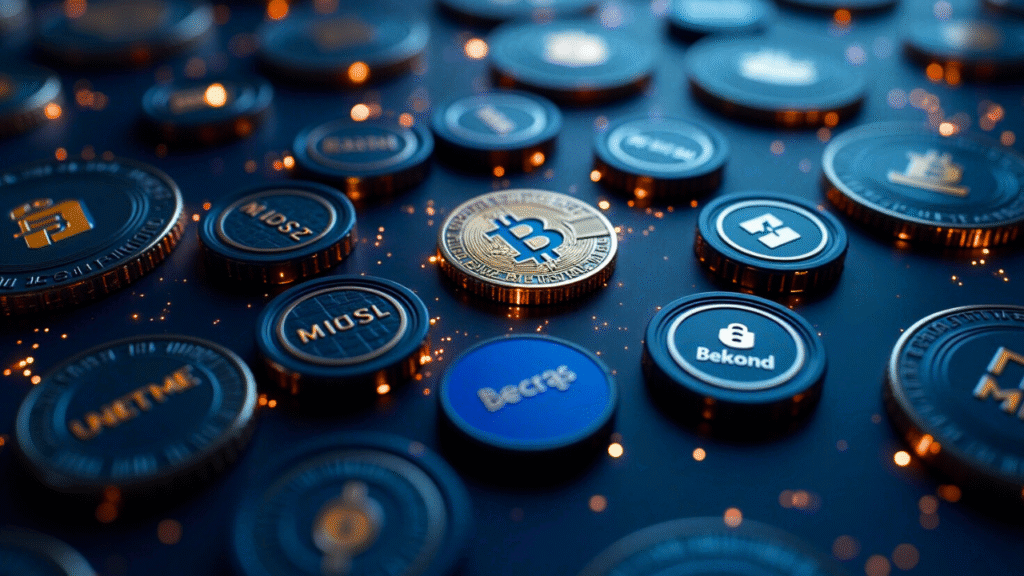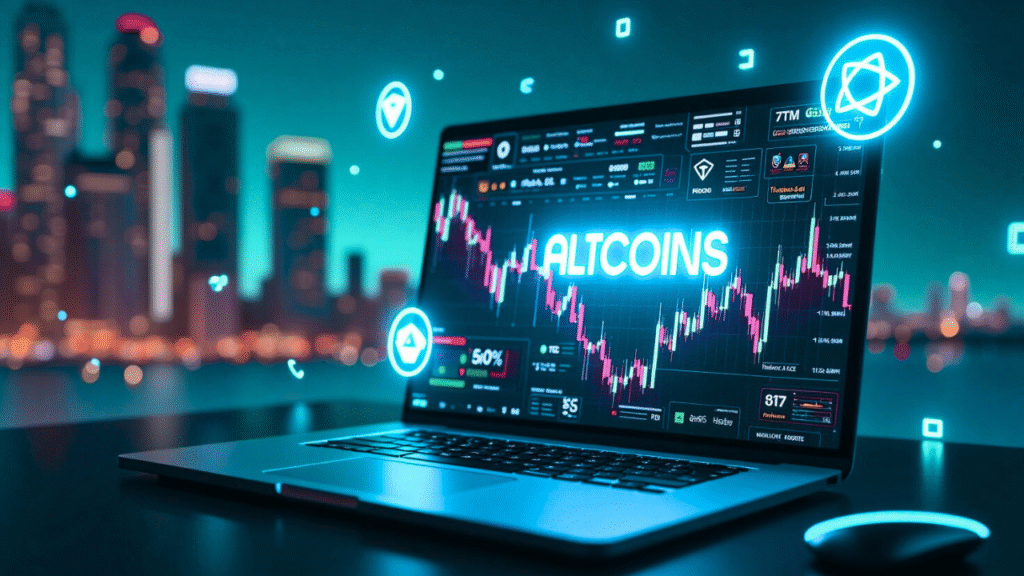What Is Altcoin?

Introduction:
Cryptocurrency has gone from a niche internet experiment to a multi-trillion-dollar global industry. At the heart of this revolution lies Bitcoin, the first digital currency that introduced the world to blockchain technology. But Bitcoin is just the beginning. Thousands of other cryptocurrencies have emerged, each with unique features and goals.
This raises a key question: whats is Altcoin and why is it so important in the digital economy?
Altcoins, short for alternative coins, represent every cryptocurrency other than Bitcoin. They exist to solve Bitcoin’s limitations or to innovate with new features ranging from faster transactions to privacy enhancements, decentralized applications (DApps), smart contracts, and even meme-driven communities.
In this article, we’ll break down everything about Altcoins: their history, types, technology, benefits, risks, real-world use cases, investment strategies, and future potential. Whether you’re a beginner or an experienced investor, this guide will provide all the insights you need.
What Is Altcoin? The Definition Explained
At its core, Altcoin refers to any cryptocurrency other than Bitcoin. While Bitcoin was the pioneer of decentralized money, Altcoins have expanded the possibilities of blockchain technology.
They differ from Bitcoin in three main ways:
- Purpose – Some are built for payments, others for smart contracts, governance, or tokenized assets.
- Technology – Altcoins often experiment with faster consensus mechanisms, privacy features, or eco-friendly mining alternatives.
- Community Vision – Each Altcoin reflects the goals of its developers and supporters.
So when someone asks, whats is Altcoin? it’s essentially an umbrella term for a diverse ecosystem of cryptocurrencies beyond Bitcoin.
The Origins and Evolution of Altcoins
Bitcoin’s launch in 2009 introduced the concept of decentralized, peer-to-peer digital currency. However, it had limitations slow transactions, high energy use, and lack of flexibility. Developers soon began creating “alternative coins” to improve or experiment with blockchain technology.
The First Wave (2011–2013): Experimentation
- Namecoin (2011): The first Altcoin, designed for decentralized domain name registration.
- Litecoin (2011): Introduced faster transaction speeds and a different hashing algorithm (Scrypt).
- Peercoin (2012): First to use proof-of-stake (PoS), a more energy-efficient consensus model.
The Second Wave (2014–2017): Smart Contracts & ICO Boom
- Ethereum (2015): Revolutionized blockchain with smart contracts and DApps.
- Ripple (XRP): Focused on fast, cross-border banking transactions.
- Dash & Monero: Enhanced privacy-focused transactions.
- 2017 ICO Boom: Hundreds of Altcoins launched, raising billions but also leading to scams.
The Third Wave (2018–2021): DeFi & NFTs
- DeFi Tokens: Uniswap (UNI), Aave (AAVE), Compound (COMP) created decentralized financial systems.
- NFT Tokens: Ethereum, Flow, and Polygon enabled the explosion of non-fungible tokens.
- Meme Coins: Dogecoin and Shiba Inu rose from jokes to billion-dollar valuations.
The Current Era (2022–2025): Institutional Interest & Regulation
As cryptocurrencies matured, the years 2022 to 2025 have become a turning point for Altcoins. Unlike the earlier “wild west” days of crypto, this period is marked by growing institutional adoption, more sophisticated technological solutions, and serious regulatory frameworks emerging across the globe.
Stablecoins as the Foundation of Digital Cash
Stablecoins like USDT (Tether), USDC (USD Coin), and DAI have established themselves as the backbone of today’s crypto economy. Unlike volatile cryptocurrencies, stablecoins are pegged to fiat currencies such as the U.S. Dollar.
- Why they matter:
- They allow traders to move in and out of volatile assets without leaving the blockchain.
- Businesses are increasingly using them for cross-border payments, cutting out banks and reducing fees.
- DeFi protocols rely on stablecoins for lending, borrowing, and liquidity pools.
By 2025, stablecoins account for trillions of dollars in annual transaction volume, making them one of the most practical forms of Altcoins in real-world use.
1. Stablecoins
Ethereum, despite being revolutionary, has long faced challenges: high gas fees and limited transaction throughput. The Layer-2 revolution has been one of the biggest shifts in this era.
- Polygon (MATIC): Offers sidechains that drastically reduce fees and speed up Ethereum transactions.
- Arbitrum & Optimism: Use rollup technology to batch transactions, increasing efficiency.
- zkSync & StarkNet: Leverage zero-knowledge proofs for lightning-fast, secure validation.
These Layer-2 Altcoin ecosystems have allowed Ethereum to host thousands of decentralized applications (DApps), from gaming and DeFi to NFTs, without crippling costs. Without Layer-2s, Ethereum might have lost ground to faster chains like Solana, Avalanche, and Algorand.
Categories of Altcoins: Beyond Bitcoin’s Shadow
When asking whats is Altcoin, it’s not enough to stop at a single definition. Altcoins are an incredibly diverse family of cryptocurrencies, each designed with specific goals in mind. Let’s break down the most important categories in detail:
2. Utility Tokens
Definition: Tokens that provide users access to specific blockchain services.
Why they matter: They are the “fuel” of blockchain ecosystems.
Key Use Cases: Paying transaction fees, staking for rewards, powering DApps.
Examples:
- Ethereum (ETH): Required for executing smart contracts.
- Binance Coin (BNB): Used for reduced trading fees and DeFi on Binance’s ecosystem.
3. Security Tokens

Definition: Digital representations of real-world assets like stocks, bonds, or real estate.
Why they matter: They combine traditional finance with blockchain efficiency.
Key Use Cases: Fractional ownership of real estate, tokenized equities.
Examples:
- Securitize Tokens: Tokenized securities regulated under U.S. law.
- Polymath Tokens: A platform for launching compliant security tokens.
4. Governance Tokens
Definition: Tokens that allow holders to vote on decisions within decentralized organizations (DAOs).
Why they matter: They enable community-driven governance, reducing reliance on centralized control.
Key Use Cases: Voting on protocol upgrades, fee structures, or treasury spending.
Examples:
- Uniswap (UNI): Holders decide on changes to the Uniswap protocol.
- Maker (MKR): Used to govern the MakerDAO ecosystem and stabilize DAI.
5. Privacy Coins
- Definition: Cryptocurrencies designed to keep transactions private and untraceable.
- Why they matter: They provide true financial anonymity in an increasingly surveilled digital world.
- Key Use Cases: Private payments, anti-censorship transactions.
- Examples:
- Monero (XMR): Uses stealth addresses and ring signatures.
- Zcash (ZEC): Offers optional “shielded” transactions with zk-SNARK technology.
6. Meme Coins
- Definition: Altcoins born from internet culture and memes, often with little intrinsic value.
- Why they matter: They highlight the power of community and virality in crypto markets.
- Key Use Cases: Speculation, community-building, fundraising for charities.
- Examples:
- Dogecoin (DOGE): Initially a joke, now accepted by major companies like Tesla.
- Shiba Inu (SHIB): Built a massive community and ecosystem despite its meme origins.
7. Interoperability Tokens
- Definition: Cryptocurrencies designed to connect multiple blockchains and enable seamless cross-chain communication.
- Why they matter: Solve blockchain’s “island problem,” where networks can’t easily interact.
- Key Use Cases: Cross-chain transfers, decentralized cross-chain apps.
- Examples:
- Polkadot (DOT): Uses parachains to connect multiple blockchains.
- Cosmos (ATOM): Employs the Inter-Blockchain Communication (IBC) protocol.
Why Do Altcoins Exist?

If Bitcoin is already valuable, why create alternatives? The answer lies in innovation:
- Transaction Speed: Bitcoin handles ~7 transactions/sec. Altcoins like Solana can process over 50,000/sec.
- Scalability: Ethereum layer-2s (Polygon, Arbitrum) handle massive DApp ecosystems.
- Privacy: Bitcoin transactions are traceable; Monero offers total anonymity.
- Diverse Use Cases: From gaming tokens to decentralized finance, Altcoins expand blockchain’s utility.
- Experimentation & Research: Altcoins test new ideas that may later influence Bitcoin itself.
Popular Altcoins in 2025
Here are some of the top Altcoins dominating today:
- Ethereum (ETH): Powers most smart contracts, NFTs, and DeFi.
- Binance Coin (BNB): Fuels Binance exchange and ecosystem.
- Cardano (ADA): Focuses on scalability and peer-reviewed research.
- Polkadot (DOT): Enables blockchain interoperability.
- Solana (SOL): Known for speed and developer-friendly environment.
- Ripple (XRP): Targets cross-border financial systems.
- Dogecoin (DOGE): Meme coin turned cultural symbol.
- Chainlink (LINK): Connects smart contracts to real-world data.
Risks of Altcoins
- Volatility: Price swings can exceed 80% in days.
- Regulatory Crackdowns: Governments may ban or restrict certain tokens.
- Scams & Rug Pulls: Many Altcoins launched with no real utility.
- Liquidity Issues: Harder to sell smaller Altcoins during market crashes.
- Security Risks: Poorly coded Altcoins are vulnerable to hacks.
Altcoins vs Bitcoin
| Feature | Bitcoin | Altcoins |
|---|---|---|
| Launch Year | 2009 | 2011 onwards |
| Market Share | ~45% of crypto market | 55% combined |
| Consensus | Proof of Work (PoW) | PoS, Delegated PoS, Hybrid |
| Use Case | Digital gold, store of value | Payments, DeFi, gaming, NFTs, governance |
| Supply | Fixed (21M BTC) | Varies (some inflationary, some capped) |
How to Invest in Altcoins Safely
If you’re researching whats is Altcoin because you’re considering investing, here’s a step-by-step guide:
- Research the Project: Check whitepapers, roadmap, and team credibility.
- Check Market Data: Look at market cap, liquidity, and trading volume.
- Pick a Secure Exchange: Use platforms like Binance, Coinbase, or Kraken.
- Store Safely: Use hardware wallets (Ledger, Trezor) for security.
- Diversify Portfolio: Spread across multiple Altcoins instead of betting on one.
- Stay Updated: Follow crypto news, regulations, and developer updates.
Real-World Use Cases of Altcoins
- Payments: Litecoin, Dash, and XRP are used for fast, low-cost payments.
- DeFi (Decentralized Finance): Ethereum, Aave, and Compound enable lending/borrowing without banks.
- NFTs: Polygon and Flow power NFT marketplaces.
- Supply Chain: VeChain tracks goods in logistics.
- Gaming: Axie Infinity’s AXS token drives play-to-earn economies.
- Healthcare: Altcoins like Solve.Care support healthcare management.
The Future of Altcoins
- Mainstream Payments: More businesses will accept Altcoins for everyday use.
- Integration with AI & IoT: Machines may transact using Altcoins in smart cities.
- Global Regulation: Legal clarity could boost adoption.
- Eco-Friendly Models: Shift from energy-heavy mining to green PoS.
- Institutional Adoption: Banks and corporations may create Altcoin-based services.
Conclusion
So, whats is Altcoin? It’s every digital currency besides Bitcoin ranging from stablecoins and DeFi tokens to meme coins and governance tokens. Altcoins represent innovation, risk, and opportunity in equal measure. They expand blockchain’s reach far beyond payments, shaping the future of finance, gaming, supply chains, and even governments.
While Bitcoin remains the king of crypto, Altcoins are the builders of tomorrow’s digital economy. Understanding them isn’t just helpful it’s essential for anyone navigating the evolving world of cryptocurrency. see
